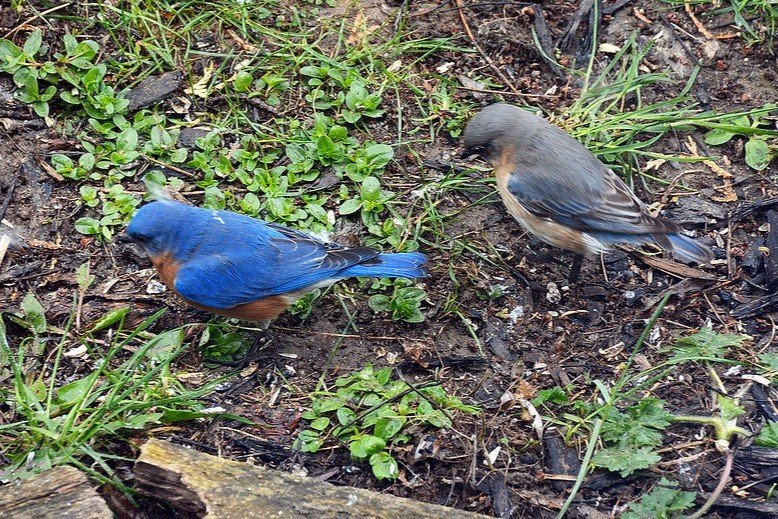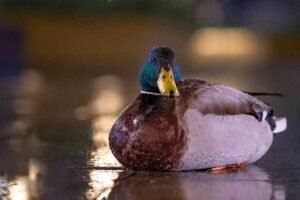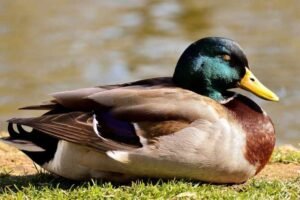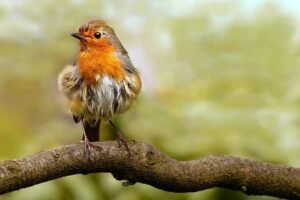Bluebirds are beautiful birds with males being brilliant blue and a rusty throat, breasts, and sides while females with a vivid sand color. To understand at what time of day do Bluebirds fledge? we need to understand that the nestlings grow very rapidly, with their eyes opening on about the eighth day.
By the time the nestlings fledge the nest box, it’s usually 16 – 20 days after hatching, they will be nearly the size of an adult bluebird.
Usually, the entire brood of fledglings leaves the box within two hours. The fledglings can fly fifty to one hundred feet on their first flight and try to land in a bush, shrub, or low branch to avoid predators.
To understand bluebird’s fledging process, we need to look into the different aspects of bluebirds breeding cycle and how bluebirds need our help to sustain their dwindling population.
What is the Bluebirds Breeding Process?
The male bluebird sits high atop a dead tree or branch or power line to hunt for insects that make up two-thirds of his diet. He and his mate also eat wild berries, especially in cold weather when insects are not available. They rarely damage cultivated crops and are very beneficial to farmers and gardeners by eating insects. The young bluebirds have spotted breasts until fall molt.
As early as the end of February and as late as June, the male bluebird locates a nesting site, establishes territory around it of two to five acres, and sings to attract a female and warn other male bluebirds to stay away. Once a female accepts the site, she builds a neat cup-shaped nest of dry grasses and pine needles. Nest building may take five days to three weeks.
The female lays one blue, or seldom white, egg each morning until three to six eggs are produced. The female begins incubating the eggs after the final egg is laid. Thirteen to fourteen days later, all eggs will hatch with hours of each other.

The adult bluebirds begin feeding the young immediately after hatching, starting with soft insects and graduating to courser food as the nestlings grow. The adults also keep the nest clean by removing the fecal sacs that enclose the nestlings’ waste.
The adult bluebirds continue to care for the young and teach them to forage for food. The male bluebird will continue this job while the female begins her second or third nest. On occasion, the young from a first nesting will help feed the nestlings from their parents’ second or third nesting.
After nesting season is over, bluebirds give up their territories and flock together. South Carolina bluebirds do not migrate. They are joined by migrant northern bluebirds and roam the area looking for berries. In winter, bluebirds will roost in pine tree stands and nest boxes to avoid cold weather.
To better understand the hatching and fledging process of bluebirds, here are some important questions that almost all bluebird enthusiasts have.
1. When do Bluebirds start nesting?
As early as February – April for the first nesting. Sometimes later if first-time nesters or multiple nesters.
2. What do they use for a nest, and what does a Bluebird nest look like?
Bluebirds typically use woven grass, pine needles, straw, hair, and sometimes feathers. Typically there will be no seed heads, cigarette butts, strings, sticks, or other junk in a Bluebird nest.
3. How many broods do they have?
Usually, Bluebirds will have two nesting’s, or in favorable conditions three.
4. How many eggs per nest, and what do they look like?
The eggs are laid one each day until the entire clutch is complete, usually 4-6 powder blue or, occasionally, white eggs.
5. How long till they hatch?
Incubation lasts approximately 12-14 days for Eastern, 13-14 days for Mountain, and 13-14 days for Western Bluebirds. Incubation usually begins right after the last egg was laid, but sometimes the female will wait a day or two.
6. How long till they leave the nest?
After hatching the chicks will remain in the nest for 16-22 days for Eastern, 17-22 for Mountain, and 19-22 days for Western Bluebirds. You should not open the box for monitoring after the 13th day after hatching or the chicks might fly from the box prematurely. The fledglings look surprisingly unlike the adult birds. They are speckled with touches of blue on the wings.
7. If I touch the eggs or babies, will the adults abandon the nest?
No. Bluebirds are quite tolerant of human monitoring of their nests. Sometimes the eggs or babies must be touched to resolve a dangerous problem from a predator or pest. Of course, unnecessary handling of the nest, eggs, and babies should be avoided.
8. Who feeds the babies?

Both parents feed the babies. Often fledglings from a previous nest also help with the feeding. It’s a family affair
I saw one of the adult birds carrying something white out of the nest box. What was it? The parents are very meticulous about cleaning up the nest box. When the eggs hatch, the female usually eats the eggshells to help with her egg production or disposes of them far away from the nest box. While the babies are growing, the parents will carry away the waste products from the nestlings. The waste is in the form of neat little bundles called “fecal sacs”.
9. Should I clean out the nest after fledging?
Yes, take the nest out, and if no parasites, save it in a plastic bag for emergency nest changes. Microwaving the nest briefly. This will kill any undesirable bacteria or hidden bugs. Wash inside of nest box with a mild solution of bleach and water. Some sources say 1 part bleach to 10 parts water, other sources suggest a 1:32 ratio. In either case, flush with plain water after disinfecting. Leave the door open until it dries.
Females have been known to start a second nest within a day of fledge day and occasionally will start a second nest in another box even before fledging occurs in the current nest. For this reason, the box should be cleaned the day after the last baby fledges or sometimes, that very day. The old nest should always be removed and disposed of far away from the nest box. An old nest, thrown away near the nest box can draw predators. Place the old nest in a plastic bag and put it in the trash.
10. The babies fledged, and now they have disappeared! What happened?
It is not unusual for the adult birds to take the new fledglings somewhere away from the nesting site for some time. If you have been feeding mealworms to the adults, then it is likely that they will continue to come for them after the babies fledge.
You may get an idea of where they have taken the babies if you watch where they go when they fly away with mealworms in their beaks. Don’t worry — the babies will probably return with the adults after a couple of weeks to teach them where they can find the mealworms for themselves. It is also quite common for the adult birds to chase away the fledglings from previous nestings once the next clutch is ready to fledge.
11. How long will the Bluebirds stay?
This depends to a great extent on where you are located, and food sources. Bluebirds do not necessarily migrate if there are plenty of native berry bushes that they can feed on during the winter months. They may seem to disappear for a few weeks in late August-early September only to return a few weeks later.
If you had been feeding mealworms during the summer, and wish to continue doing so for the winter, you might have a group of Bluebirds stay with you for the winter. During nesting season, the birds are very territorial, but when nesting season is over, they tend to live in loose flocks comprised of the parents and young birds from all the nestings from the season.
Why Do Bluebirds Need Our Help?
Between the 1920s and the 1970s, the bluebird population declined by an estimated 90%. There are several reasons for this but the main ones are loss of habitat and competition from other species.
1. Loss of Habitat
The bluebird is a cavity-nesting bird, which means it prefers to build its nest in a tree cavity. Unlike the woodpecker, however, the bluebird’s beak is no suited for excavating. It depends on natural cavities or ones made by other birds. However, the expansion of large commercial or agricultural operations, growth of cities, and dense residential land development have destroyed many of the bluebirds’ natural nesting places.
2. Competition With Other Birds
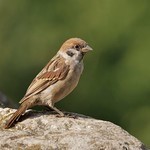
The main source of competition for bluebirds is a bird that is not native to North America – the House or English sparrow. The House Sparrow was introduced to this country in the mid-1800s. It was thought that this bird would help control insect pests; however, those that brought them here seriously underestimated this bird’s fiercely competitive nature.
The House Sparrow population exploded, while that of the bluebird declined alarmingly. While House Sparrows will nest about anywhere they can find a nook or cranny, they compete with the more finicky bluebird, and will often drive away adult bluebirds, leaving bluebird nestlings to starve to death. Worse, they will also peck open unhatched bluebird eggs and kill the babies, or even adults they happen to find sitting on the nest. They have even been known to build their nests on top of the bodies of the bluebirds they have killed.
Another source of competition for the bluebird is the Eastern Starling, a bird that is equally aggressive and will also kill both bluebird adults and young.
What Can You Do To Help Bluebirds?
Birdhouses are readily available, but not everything called a “bluebird house” is suitable for them. Real bluebird conservation takes a bit of effort, but it is well worth your time and effort when you see your first brood of fledglings take flight. Several things to keep in mind when you decide to put up a nest box for bluebirds are:
1. Selecting a Suitable Location
Bluebirds prefer to nest in an area that includes open space, scattered trees, and low ground covers such as lawns, golf courses, pastureland, parks, and school & industrial campuses. They do not nest in heavily forested areas. They also do not like the completely open land (no trees or shrubs), but one that still provides perches for hunting (such as fences, telephone lines, posts, shepherd’s hooks, etc.) and trees nearby for both shade and to offer the baby birds a safe destination for fledging.
Care should be taken not to place the nest box so close to trees and fences, which predators are afforded easy access to the box from above. Keep boxes at least 200 yards from barnyards and feedlots where House Sparrows are abundant. Avoid areas with heavy pesticide use. Bluebirds are territorial, so multiple boxes should be placed at least 100 feet apart as a rough guide. Vegetation and topography might make a closer location possible. There should be no direct line of sight between multiple boxes.
2. Choose The Correct Nest Box
No products found.
Purchase or build a nest box designed specifically for bluebirds. Preferably, these are made of unpainted cedar, redwood, Cyprus, or pine. If you must paint your nest box, it should be painted ONLY on the outside, in a very light color, to avoid overheating. The box should have an overhanging slanted roof, NO perch, and a round entrance hole.
It should have ventilation and drainage holes, be deep enough so predators can’t reach in to get to the eggs, and have a door that opens for ease of monitoring and cleaning. In areas of intense heat, additional measures should be taken to avoid overheating, such as the use of 3/4″ lumber, an overhanging roof on all sides, and placement in a location that receives shade from the afternoon sun.
3. Proper Mounting of The Nest Boxes
Nest boxes may be mounted at any time, but to attract bluebirds for their first nesting of the season, they should be in place by mid-March, depending on your geographic location. You may see nest boxes mounted on trees, wooden fence posts, or metal poles. SCBS highly recommends mounting nest boxes on a metal or plastic pole with a predator baffle to deter critters such as snakes and raccoons:”
Metal poles may be difficult for predators such as snakes and raccoons to climb. A metal mounting post need not be elaborate or expensive. Smooth, round 1″ electrical conduit is inexpensive and works well; although any smooth scrap round pipe will work. The next box should be mounted on the post so that the entrance hole is 5 feet off the ground.
4. Regular Monitoring Nest Boxes
Being a conscientious bluebird landlord involves more than simply buying or making a nest box and mounting it in a good location. Nest boxes should be monitored at least once a week to be sure that undesirable competitors are not using them. They should also be monitored for blowflies, ants, and other parasites, and predator problems.
Bluebirds readily tolerate humans monitoring their nest boxes. They will not abandon their young because humans have looked at or touched them. Bluebirds do not have a good sense of smell, so your scent on their nest will not disturb them. Care should always be taken when opening a nest box, especially once the hatchlings are 12 days old, as this could cause them to fledge too early.
The nest box should be cleaned out after each brood of babies has fledged. Bluebirds will not reuse a nest. They will typically produce three broods of three to six young by from March to August in South Carolina.
5. Feeding Bluebirds
It is not normally necessary to feed bluebirds; however, many people find they enjoy offering treats to their birds, both to help them through times of difficulty, and to have the opportunity to interact more closely with these gentle, trusting creatures. They eat insects and insect larvae and berries. Some common native berry bushes that bluebirds enjoy are Flowering Dogwood, Holly, Juniper, Sumac, Mountain-ash, Mistletoe, Hackberry, and Firethorn. Another food commonly offered to bluebirds is mealworms.
No products found.
They can be purchased in bulk from several mail-order houses, or obtained locally at bait shops, and wild bird supply stores. During the winter months, bluebirds will come to suet feeders and seed feeders containing sunflower meats. One caution is if you like to feed other species of birds – do not place your bluebird nest boxes too close to your wild bird feeding area. Feeding seed “blends” containing corn, milo, and millet, or feeding stale bread, rolls or doughnuts will attract house sparrows to your yard, and endanger your bluebirds. Bluebirds also enjoy shallow birdbaths, especially those with a drip/misting feature.
Last update on 2023-07-31 / Affiliate links / Images from Amazon Product Advertising API

